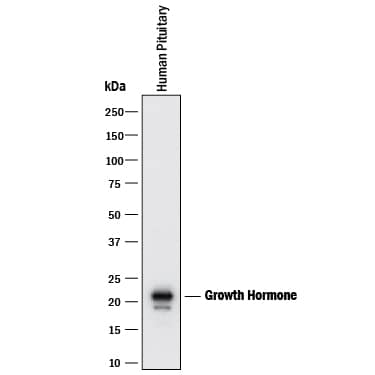Human Growth Hormone Antibody
R&D Systems, part of Bio-Techne | Catalog # MAB1067

Key Product Details
Species Reactivity
Validated:
Cited:
Applications
Validated:
Cited:
Label
Antibody Source
Product Specifications
Immunogen
Phe27-Phe217
Accession # CAA23779
Specificity
Clonality
Host
Isotype
Endotoxin Level
Scientific Data Images for Human Growth Hormone Antibody
Detection of Human Growth Hormone by Western Blot.
Western blot shows lysates of human pituitary gland tissue. PVDF membrane was probed with 2 µg/mL of Mouse Anti-Human Growth Hormone Monoclonal Antibody (Catalog # MAB1067) followed by HRP-conjugated Anti-Mouse IgG Secondary Antibody (Catalog # HAF018). A specific band was detected for Growth Hormone at approximately 22 kDa (as indicated). This experiment was conducted under reducing conditions and using Immunoblot Buffer Group 1.Cell Proliferation Induced by Growth Hormone and Neutralization by Human Growth Hormone Antibody.
Recombinant Human Growth Hormone (Catalog # 1067-GH) stimulates proliferation in the Nb2-11 rat lymphoma cell line in a dose-dependent manner (orange line). Proliferation elicited by Recombinant Human Growth Hormone (0.2 ng/mL) is neutralized (green line) by increasing concentrations of Mouse Anti-Human Growth Hormone Monoclonal Antibody (Catalog # MAB1067). The ND50 is typically 2-8 µg/mL.Applications for Human Growth Hormone Antibody
Western Blot
Sample: Human pituitary gland tissue
Neutralization
Formulation, Preparation, and Storage
Purification
Reconstitution
Formulation
Shipping
Stability & Storage
- 12 months from date of receipt, -20 to -70 °C as supplied.
- 1 month, 2 to 8 °C under sterile conditions after reconstitution.
- 6 months, -20 to -70 °C under sterile conditions after reconstitution.
Background: Growth Hormone
Growth hormone (GH), also known as somatotropin, is a member of a family of growth factors that includes prolactin, placental lactogens, proliferins, and somatolactin (1, 2). It is synthesized primarily by somatotropes in the anterior pituitary and is stored in secretary granules. The pulsatile release of GH into circulation is regulated by the concerted actions of the hypothalamic hormones, GH-releasing hormone (GHRH) and somatostatin (SST), as well as by signals from the periphery, ghrelin (3) and leptin (4). The human GH cDNA encodes a 217 amino acid (aa) precursor protein with a 26 aa putative signal peptide. By alternative splicing, at least four isoforms of GH have been identified (5). Human GH is a pleiotropic cytokine that exerts its biological actions by binding to the transmembrane GH receptor, which is present in many cell types (1, 2). GH stimulates the liver and other tissues to produce IGF-I, which regulates growth and metabolism. GH has also been shown to have direct effects on growth that is independent of IGF-I. GH, directly or indirectly via IGF-I, can act on B cells, T cells, NK cells, macrophages, and neutrophils to exert immunomodulatory activities (6). In addition, GH can act directly on various cell types to induce lipolysis, lactation, amino acid uptake, and protein synthesis (1, 2, 6).
References
- Goffin, V. et al. (1996) Endocrine Rev. 17:385.
- Le Roith, D. et al. (2001) Endocrine Rev. 22:53.
- Kojima, K. et al. (1999) Nature 402:656.
- Tannenbaum, G. et al. (1998) Endocrinol. 139:3871.
- Welniak, L.A. et al. (2002) J. Leukoc. Biol. 71:381.
Alternate Names
Entrez Gene IDs
Gene Symbol
UniProt
Additional Growth Hormone Products
Product Documents for Human Growth Hormone Antibody
Product Specific Notices for Human Growth Hormone Antibody
For research use only

